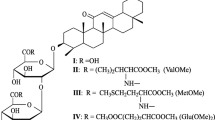Summary
CL 259,763, N-[4-[(4-fluorophenyl)sulfonyl]phenyl] acetamide, is an orally active compound capable of modifying the reactivity of certain lymphoid cell populations affected by the growth of a tumor. The compound augmented the response of lymphocytes from tumor-primed animals to syngeneic tumor cells, resulting in a marked increase in tumor cell destruction. Likewise, it enhanced macrophage inhibitory effects on the growth of tumor cells in vitro. These “activated” macrophages were detectable in peritoneal exudates of treated mice 4 to 12 days after receiving a single oral dose of CL 259,763, with peak activity being demonstrable by day 7. The compound also restored the alloreactivity of lymphocytes from immunodepressed mice bearing the Lieberman plasma cell tumor, possibly by interferring with suppressor cells. Macrophages and lymphocytes from treated mice released significantly more IL-1 and IL-2-like factors in culture than did the control counterparts. Sera from treated mice also possessed more colony stimulating factor than those from normal mice. Immunoadjuvant effects were evident when the compound was administered with an inactivated L1210 leukemia vaccine and it enhanced the effectiveness of cytotoxic chemotherapy when given to mice challenged with P388 murine leukemia. These immunomodulating effects of CL 259,763 may hopefully be exploited in efforts to augment the immune response of the host to a progressively growing tumor.
Similar content being viewed by others
References
Bast RC, Berek JS, Obrist R, Griffiths CT, Berkowitz RS, Hacker NF, Parker L, Lagasse LD, Knapp RC (1983) Intraperitoneal immunotherapy of human ovarian carcinoma with Corynebacterium parvum. Cancer Res 43: 1395–1401
Burnet FM (1971) Immunological surveillance in neoplasia. Transplant Rev 7: 3–25
Chen Y, Hwang LT, Heller P (1982) Immunosuppression in plasmacytoma: induction of suppressor cells. Clin Exp Immunol 47: 191–196
Chow DA, Green MI, Greenberg AH (1979) Macrophage-dependent, NK-cell-independent “natural” surveillance of tumors in syngeneic mice. Int J Cancer 23: 788–791
Dillman RO, Beauregard JC, Mendelsohn J, Green MR, Howell SB, Royston I (1982) Phase I trials of thymosin fraction 5 and thymosin α-1. J Biol Response Mod 1: 35–41
Eilber FR, Morton DL (1970) Impaired immunologic reactivity and recurrence following cancer surgery. Cancer 25: 362–367
Evans CH (1983) Lymphokines, homeostasis, and carcinogenesis. J Natl Cancer Inst 71: 253–257
Gatti RA, Good RA (1976) Occurrence of malignancy in immunodeficiency diseases. In: Lynch HT (ed) Cancer genetics. Charles Thomas, Springfield, IL. pp 63–75
Katzmann JA (1978) Myeloma-induced immunosuppression: a multistep mechanism. J Immunol 121: 1405–1409
Kennard J, Zolla-Pazner S (1980) Origin and function of suppressor macrophages in myeloma. J Immunol 124: 268–273
Lamm KL, Thor DE, Harris SC, Stogdill VD, Radwin HM (1982) Intravesical and percutaneous BCG immunotherapy of recurrent superficial bladder cancer. In: Terry WD, Rosenberg SA (eds) Immunotherapy of human cancer. Excerpte Medica, New York pp 315–322
Law LW (1965) Neoplasms in thymectomized mice following room infection with polyoma virus. Nature 205: 672–673
Lichtenstein A, Murahata R, Sugasawara R, Zighelboim J (1981) Suppressor T cells and suppressor macrophages induced by Corynebacterium parvum. Cell Immunol 58: 257–268
Lotze MT, Robb RJ, Sharrow SO, Frana LW, Rosenberg SA (1984) Systemic administration of interleukin-2 in humans. J Biol Response Mod 3: 475–482
Louie A, Gallagher J, Sikora K, Levy R, Rosenberg S, Merigan T (1981) Follow-up observations on the effect of human leukocyte interferon on non-Hodgkin's lymphoma. Blood 58: 712–718
Mackaness GB (1976) Role of macrophages in host defense mechanism. In Fink MA (ed) The macrophage in neoplasia. Academic Press Inc, New York, pp 3–13
Oldham RK (1983) Biological response modifiers. J Natl Cancer Inst 70: 789–796
Ritz J, Schlossman SF (1982) Utilization of monoclonal antibodies in treatment of leukemia and lymphoma. Blood 59: 1–11
Schwartz RS (1975) Another look at immunologic surveillance. New Engl J Med 293: 181–184
Warner JF, Dennert G (1982) Effects of a cloned cell line with NK activity on bone marrow transplants, tumor development and metastasis in vivo. Nature 300: 31–34
Yu AS, Bernstein ID (1982) T helper cells in immune mice amplify the primary anti-tumor cytotoxic response. J Immunol 129: 856–859
Zolla S (1972) Effect of plasmacytomas on the immune response of mice. J Immunol 108: 1039–1048
Author information
Authors and Affiliations
Rights and permissions
About this article
Cite this article
Wang, B.S., Ruszala-Mallon, V., Wallace, R.E. et al. Modulation of the immune response to tumors by a novel synthetic compound, N-[4-[(4-fluorophenyl)sulfonyl]phenyl] acetamide (CL 259,763). Cancer Immunol Immunother 22, 8–14 (1986). https://doi.org/10.1007/BF00205710
Received:
Accepted:
Issue Date:
DOI: https://doi.org/10.1007/BF00205710




